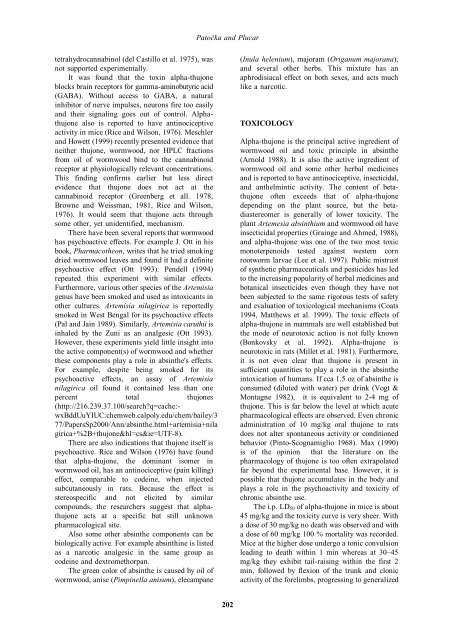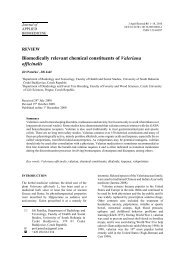Pharmacology and toxicology of absinthe
Pharmacology and toxicology of absinthe
Pharmacology and toxicology of absinthe
You also want an ePaper? Increase the reach of your titles
YUMPU automatically turns print PDFs into web optimized ePapers that Google loves.
Patočka <strong>and</strong> Plucar<br />
tetrahydrocannabinol (del Castillo et al. 1975), was<br />
not supported experimentally.<br />
It was found that the toxin alpha-thujone<br />
blocks brain receptors for gamma-aminobutyric acid<br />
(GABA). Without access to GABA, a natural<br />
inhibitor <strong>of</strong> nerve impulses, neurons fire too easily<br />
<strong>and</strong> their signaling goes out <strong>of</strong> control. Alphathujone<br />
also is reported to have antinociceptive<br />
activity in mice (Rice <strong>and</strong> Wilson, 1976). Meschler<br />
<strong>and</strong> Howett (1999) recently presented evidence that<br />
neither thujone, wormwood, nor HPLC fractions<br />
from oil <strong>of</strong> wormwood bind to the cannabinoid<br />
receptor at physiologically relevant concentrations.<br />
This finding confirms earlier but less direct<br />
evidence that thujone does not act at the<br />
cannabinoid receptor (Greenberg et all. 1978,<br />
Browne <strong>and</strong> Weissman, 1981, Rice <strong>and</strong> Wilson,<br />
1976). It would seem that thujone acts through<br />
some other, yet unidentified, mechanism.<br />
There have been several reports that wormwood<br />
has psychoactive effects. For example J. Ott in his<br />
book, Pharmacotheon, writes that he tried smoking<br />
dried wormwood leaves <strong>and</strong> found it had a definite<br />
psychoactive effect (Ott 1993). Pendell (1994)<br />
repeated this experiment with similar effects.<br />
Furthermore, various other species <strong>of</strong> the Artemisia<br />
genus have been smoked <strong>and</strong> used as intoxicants in<br />
other cultures. Artemisia nilagirica is reportedly<br />
smoked in West Bengal for its psychoactive effects<br />
(Pal <strong>and</strong> Jain 1989). Similarly, Artemisia caruthii is<br />
inhaled by the Zuni as an analgesic (Ott 1993).<br />
However, these experiments yield little insight into<br />
the active component(s) <strong>of</strong> wormwood <strong>and</strong> whether<br />
these components play a role in <strong>absinthe</strong>'s effects.<br />
For example, despite being smoked for its<br />
psychoactive effects, an assay <strong>of</strong> Artemisia<br />
nilagirica oil found it contained less than one<br />
percent total thujones<br />
(http://216.239.37.100/search?q=cache:-<br />
wxBddUuYIUC:chemweb.calpoly.edu/chem/bailey/3<br />
77/PapersSp2000/Ann/<strong>absinthe</strong>.html+artemisia+nila<br />
girica+%2B+thujone&hl=cs&ie=UTF-8).<br />
There are also indications that thujone itself is<br />
psychoactive. Rice <strong>and</strong> Wilson (1976) have found<br />
that alpha-thujone, the dominant isomer in<br />
wormwood oil, has an antinociceptive (pain killing)<br />
effect, comparable to codeine, when injected<br />
subcutaneously in rats. Because the effect is<br />
stereospecific <strong>and</strong> not elicited by similar<br />
compounds, the researchers suggest that alphathujone<br />
acts at a specific but still unknown<br />
pharmacological site.<br />
Also some other <strong>absinthe</strong> components can be<br />
biologically active. For example absinthine is listed<br />
as a narcotic analgesic in the same group as<br />
codeine <strong>and</strong> dextromethorpan.<br />
The green color <strong>of</strong> <strong>absinthe</strong> is caused by oil <strong>of</strong><br />
wormwood, anise (Pimpinella anisum), elecampane<br />
(Inula helenium), majoram (Origanum majorana),<br />
<strong>and</strong> several other herbs. This mixture has an<br />
aphrodisiacal effect on both sexes, <strong>and</strong> acts much<br />
like a narcotic.<br />
TOXICOLOGY<br />
Alpha-thujone is the principal active ingredient <strong>of</strong><br />
wormwood oil <strong>and</strong> toxic principle in <strong>absinthe</strong><br />
(Arnold 1988). It is also the active ingredient <strong>of</strong><br />
wormwood oil <strong>and</strong> some other herbal medicines<br />
<strong>and</strong> is reported to have antinociceptive, insecticidal,<br />
<strong>and</strong> anthelmintic activity. The content <strong>of</strong> betathujone<br />
<strong>of</strong>ten exceeds that <strong>of</strong> alpha-thujone<br />
depending on the plant source, but the betadiastereomer<br />
is generally <strong>of</strong> lower toxicity. The<br />
plant Artemesia absinthium <strong>and</strong> wormwood oil have<br />
insecticidal properties (Grainge <strong>and</strong> Ahmed, 1988),<br />
<strong>and</strong> alpha-thujone was one <strong>of</strong> the two most toxic<br />
monoterpenoids tested against western corn<br />
rootworm larvae (Lee et al. 1997). Public mistrust<br />
<strong>of</strong> synthetic pharmaceuticals <strong>and</strong> pesticides has led<br />
to the increasing popularity <strong>of</strong> herbal medicines <strong>and</strong><br />
botanical insecticides even though they have not<br />
been subjected to the same rigorous tests <strong>of</strong> safety<br />
<strong>and</strong> evaluation <strong>of</strong> toxicological mechanisms (Coats<br />
1994, Matthews et al. 1999). The toxic effects <strong>of</strong><br />
alpha-thujone in mammals are well established but<br />
the mode <strong>of</strong> neurotoxic action is not fully known<br />
(Bonkovsky et al. 1992). Alpha-thujone is<br />
neurotoxic in rats (Millet et al. 1981). Furthermore,<br />
it is not even clear that thujone is present in<br />
sufficient quantities to play a role in the <strong>absinthe</strong><br />
intoxication <strong>of</strong> humans. If cca 1.5 oz <strong>of</strong> <strong>absinthe</strong> is<br />
consumed (diluted with water) per drink (Vogt &<br />
Montagne 1982), it is equivalent to 2-4 mg <strong>of</strong><br />
thujone. This is far below the level at which acute<br />
pharmacological effects are observed. Even chronic<br />
administration <strong>of</strong> 10 mg/kg oral thujone to rats<br />
does not alter spontaneous activity or conditioned<br />
behavior (Pinto-Scognamiglio 1968). Max (1990)<br />
is <strong>of</strong> the opinion that the literature on the<br />
pharmacology <strong>of</strong> thujone is too <strong>of</strong>ten extrapolated<br />
far beyond the experimental base. However, it is<br />
possible that thujone accumulates in the body <strong>and</strong><br />
plays a role in the psychoactivity <strong>and</strong> toxicity <strong>of</strong><br />
chronic <strong>absinthe</strong> use.<br />
The i.p. LD 50 <strong>of</strong> alpha-thujone in mice is about<br />
45 mg/kg <strong>and</strong> the toxicity curve is very sheer. With<br />
a dose <strong>of</strong> 30 mg/kg no death was observed <strong>and</strong> with<br />
a dose <strong>of</strong> 60 mg/kg 100 % mortality was recorded.<br />
Mice at the higher dose undergo a tonic convulsion<br />
leading to death within 1 min whereas at 30–45<br />
mg/kg they exhibit tail-raising within the first 2<br />
min, followed by flexion <strong>of</strong> the trunk <strong>and</strong> clonic<br />
activity <strong>of</strong> the forelimbs, progressing to generalized<br />
202





